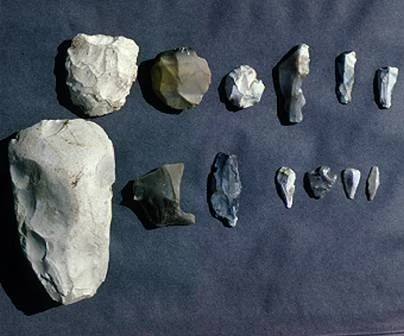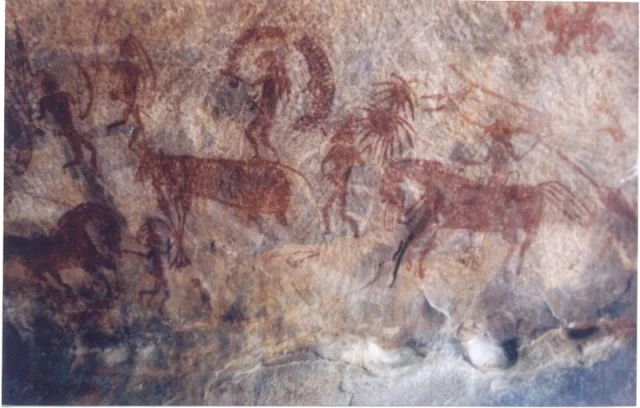Early
Hominids
Human-like
animals that walked upright were known as hominids. It is believed that the
earliest hominids lived around 4.4 million years ago in the humid forests of
eastern and southern Africa. These animals, known as Australopithecus, are
believed to have been around three to five feet tall, and probably fed on
leaves, fruits, and the remains of dead animals. There is no evidence that
Australopithecus made their own tools. There is, however, strong evidence that
they used sticks and bones to help them dig and defend themselves.
Early
Modern Humans:
The
earliest representatives of people anatomically similar to living humans
evolved from more archaic humans approximately 100,000 years ago.Early modern
humans were biologically the same as modern peoples and would blend in with
living peoples. They differed from living people primarily in their tendency to
have a rugged, athletic build. These populations were generally tall, males
being 175–180 cm (5 ft 10 in.) and females 160–165 cm (5 ft 4 in.) on average.
As a result of these tall bodies and muscularity, their brains were relatively
large, averaging about 1500 cm3 (90 in.3) as opposed to averages of about 1350
cm3 (80 in.3) common for recent humans. Yet, when their brain sizes are scaled
against estimated body weights, their brains were relatively the same size as
those of living humans.
 |
| Imaginery recreation of early Human |
 |
| Comparative Skull
structure of Modern (Left) And Early Human (Right) |
Early
modern humans were successful hunters and gatherers, occupying most of the
inhabitable regions of the Old World.
They lived by hunting small to medium-size animals,and Big animals especially antelopes, deer, goats, and occasional horses and cattle(Bison),Mammoth and by gathering wild plants, fish, and shellfish for food. Their effectiveness as hunters and gatherers was due in part to their technology. They developed elaborate stone tool technologies, producing long blades that became blanks for tools with replaceable cutting edges and points. They were also the
 |
| Haunting of Mammoth by the stone age Humans |
 |
| Haunting Bison By early Stone age Human |
They lived by hunting small to medium-size animals,and Big animals especially antelopes, deer, goats, and occasional horses and cattle(Bison),Mammoth and by gathering wild plants, fish, and shellfish for food. Their effectiveness as hunters and gatherers was due in part to their technology. They developed elaborate stone tool technologies, producing long blades that became blanks for tools with replaceable cutting edges and points. They were also the
first to
fire clay into ceramics, and they wove carrying bags with a variety of
techniques. Yet, their ability to live effectively as hunters and gatherers
depended upon their extensive knowledge of the environment. This knowledge was
communicated through the first elaborate symbolic systems known, which
consisted of a variety of geometric notational systems and the first
representational art. They were also the first humans to commonly wear jewelry,
and hence to modify their personal social images, suggesting more complex
social roles than were previously known. Although these behavioral advances are
associated with early modern humans, most of them appear only after about
50,000 years ago and hence are associated with the dispersal of modern humans.
Tools and
the Stone Age:
One of
the most important advancements in human history was the development and use of
tools. Tools allowed hominids to become the masters of their environments, to
hunt, to build, and to perform important tasks that made life easier for them.
The first tools were made out of stone. Thus, historians refer to the period of
time before written history as the Stone Age.
Historians
divide the Stone Age into three different periods based on the sophistication
and methods of tool design. The first such period is referred to as the
Paleolithic, or Old Stone Age. The Old Stone Age began about 2 million years
ago with the development of the first tools by Homo habilis and lasted until
around 12,000 years ago. The Mesolithic, or Middle Stone Age, began around
12,000 years ago and continued through about 8,000 years ago. The Neolithic, or
New Stone Age, lasted from 8,000 years until around 5,000 years ago.
During
the Paleolithic, which is subdivided into Lower, Middle, and Upper periods,
humans learned how to make rough-shaped stones for several purposes, using a
technique known as Oldowan, because of the Olduwai Gorge in Tanzania, the site
where many hominid fossils and stone tools were found. These tools were made
simply by hitting two cobblestones against each other, so that eventually
smaller stones with sharp edges were obtained. This is called
"flaking", and the best stones for doing it is the flint (silex).
 |
| Very early stone tools and Bracelet |
Humans
used them to kill animals, break bones, slice meat, scrape hides, cut branches
and sharpen wood sticks. Access to rich sources of fat and protein hidden in
bone marrow, brain and muscles of dead or fresh-killed animals was very
important for men's further evolution, because it provided them with enough
energy to sustain a larger brain, as well to run for a long time after edible
prey. Hominids and early humans lived probably on a mixed diet obtained by
foraging, scavenging and hunting.
These
three activities are progressively more effective in terms of caloric return of
investment of time and effort, and the "discovery" of tools for
scavenging for the brain and bone marrow and for killing prey was the major
amplifying factor that "exploded" human evolution within a few
hundred thousand years.
Tool
Making Process of Stone Age:
A stone
tool is, in the most general sense, any tool made either partially or entirely
out of stone. Although stone tool-dependent societies and cultures still exist
today, most stone tools are associated with prehistoric, particularly Stone Age
cultures that have become extinct. Archaeologists often study such prehistoric
societies, and refer to the study of stone tools as lithic analysis. Stone has
been used to make a wide variety of different tools throughout history,
including arrow heads, spearpoints and querns. Stone tools may be made of
either ground stone or chipped stone, and a person who creates tools out of the
latter is known as a flintknapper.
Chipped
stone tools are made from cryptocrystalline materials such as chert or flint,
radiolarite, chalcedony, basalt, quartzite and obsidian via a process known as
lithic reduction. One simple form of reduction is to strike stone flakes from a
nucleus (core) of material using a hammerstone or similar hard hammer
fabricator. If the goal of the reduction strategy is to produce flakes, the
remnant lithic core may be discarded once it has become too small to use.
In some
strategies, however, a flintknapper reduces the core to a rough unifacial or
bifacial preform, which is further reduced using soft hammer flaking techniques
or by pressure flaking the edges. More complex forms of reduction include the
production of highly standardized blades, which can then be fashioned into a
variety of tools such as scrapers, knives, sickles and microliths. In general
terms, chipped stone tools are nearly ubiquitous in all pre-metal-using
 |
Axe heads
found at a 2700 BC Neolithic manufacture site in Switzerland,
arranged
in the various stages of production from left to right
|
societies
because they are easily manufactured, the tool stone is usually plentiful, and
they are easy to transport and sharpen.
Discvery
of Fire:
Prehistoric
men knew about fire. They must have discovered it by chance, perhaps when
lightening caused a fire or when the sun, shining on dry leaves, caused them to
ignite. To our ancestors, the discovery of fire was a important as the
discovery of electricity or atomic energy has been to us. It was so important
that to the primitive mind of early man it seemed holy, a gift from the gods,
and become the subject of many myths. In ancient mythology fire worship
reappears often.
One of
the ways in which prehistoric men made fire was by rubbing two pieces of wood
together. It could also be done by rubbing two flint stones together.
Once man
has discovered fire, he could warm himself in front of the flames and cook the
flesh of animals (previously he had eaten meat raw). Fire bought light into the
dark caves. As time went by and men lived in houses, a fire in the hearth
helped to create a homely atmosphere.
Rock
paintings:
 |
| maginery
Scene where Early stone age Human
painting
on Cave
|
In paleolithic times, mostly animals were painted, in theory ones that were used as food or represented strength, such as the rhinoceros or large cats (as in the Chauvet Cave). Signs such as dots were sometimes drawn. Rare human representations include handprints and half-human/half-animal figures. The Cave of Chauvet in the Ardèche département, France, contains the most important cave paintings of the paleolithic era, dating from about 31,000 BCE. The Altamira cave paintings in Spain were done 14,000 to 12,000 BCE and show, among others, bisons. The hall of bulls in Lascaux, Dordogne, France, dates from about 15,000 to 10,000 BCE.
 |
A modern
interpretation of the bison from the Altamira cave ceiling,
one of
the most famous paintings in the cave
|
The
meaning of many of these paintings remains unknown. They may have been used for
seasonal rituals. The animals are accompanied by signs that suggest a possible
magic use. Arrow-like symbols in Lascaux are sometimes interpreted as calendar
or almanac use, but the evidence remains interpretative.
Some
scenes of the Mesolithic, however, can be typed and therefore, judging from
their various modifications, are fairly clear. One of these is the battle scene
between organized bands of archers. For example, "the marching
Warriors," a rock painting at Cingle de la Mola, Castellón in Spain, dated
to about 7,000–4,000 BCE, depicts about 50 bowmen in two groups marching or
running in step toward each other, each man carrying a bow in one hand and a
fistful of arrows in the
other. A
file of five men leads one band, one of whom is a figure with a "high
crowned hat." In other scenes elsewhere, the men wear head-dresses and
knee ornaments but otherwise fight nude. Some scenes depict the dead and
wounded, bristling with arrows. One is reminded of Ötzi the Iceman, a Copper
Age mummy revealed by an Alpine melting glacier, who collapsed from loss of
blood due to an arrow wound in the back.
 |
Prehistoric
cave paintings. Santo Domingo
|

































 Online Movies
Online Movies
No comments:
Post a Comment